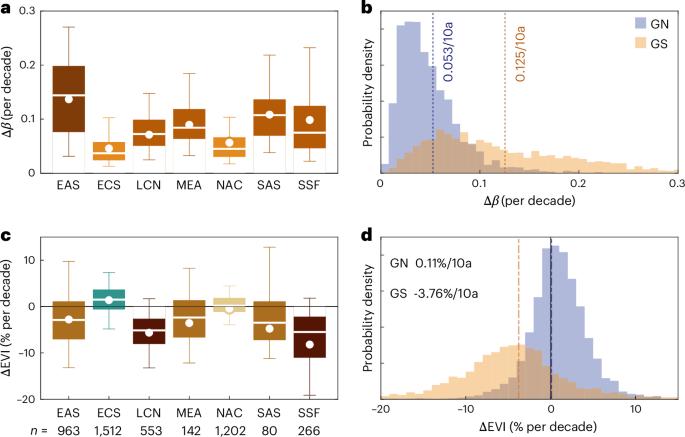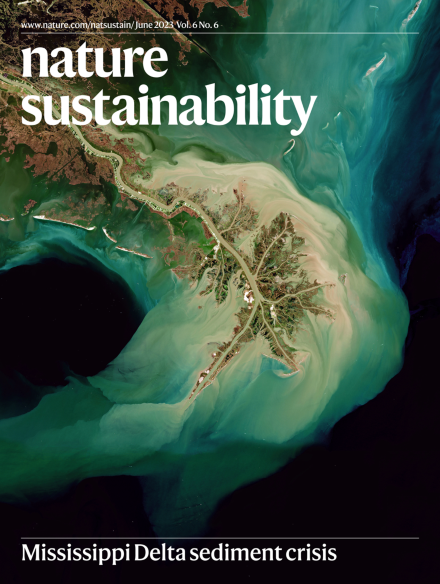Contrasting effects of urbanization on vegetation between the Global South and Global North
IF 27.1
1区 环境科学与生态学
Q1 ENVIRONMENTAL SCIENCES
引用次数: 0
Abstract
Urban vegetation, the core component of green infrastructure and critical for sustainable cities, is profoundly affected by the process of urbanization. Urbanization not only leads to substantial vegetation loss (direct impact) but also fosters urban vegetation growth (indirect impact). However, the extent to which these direct and indirect impacts affect vegetation dynamics across cities worldwide and how urban greening will change in the future remain unclear. Using satellite-based greenness and impervious surface datasets, we show that positive indirect impacts mitigated 56.85% of the negative direct impacts across 4,718 cities worldwide from 2000 to 2019. Notably, the offsetting coefficient is much greater in Global North cities (79.13%) than in Global South cities (38.01%) partly due to their socioeconomic differences. This disparity in urban greening dynamics will continue in the future. Approximately 60% of Global North cities and 30% of Global South cities will become greener by 2040. Our results reveal the divergent trade-offs between vegetation loss and enhanced vegetation growth in cities of different socioeconomic levels and stages of urbanization. Such insights are crucial for a comprehensive understanding of urban greening dynamics and for devising strategies to attain sustainable development goals. Understanding the urbanization-driven vegetation dynamics is currently limited but would be important knowledge to guide sustainable urban development. This study explores such impacts across 4,718 cities worldwide and reveals divergent dynamics of vegetation loss and urban vegetation growth.

全球南方和全球北方城市化对植被的影响对比
城市植被是绿色基础设施的核心组成部分,是城市可持续发展的关键,受到城市化进程的深刻影响。城市化不仅导致大量植被损失(直接影响),而且促进了城市植被的生长(间接影响)。然而,这些直接和间接的影响在多大程度上影响了全球城市的植被动态,以及未来城市绿化将如何变化,目前仍不清楚。利用基于卫星的绿化和不透水面数据集,我们发现,从2000年到2019年,全球4,718个城市的积极间接影响减轻了56.85%的负面直接影响。值得注意的是,全球北方城市的抵消系数(79.13%)远高于全球南方城市(38.01%),部分原因是它们的社会经济差异。这种城市绿化动态的差异将在未来继续存在。到2040年,大约60%的全球北方城市和30%的全球南方城市将变得更加环保。研究结果表明,不同社会经济水平和城市化阶段的城市,植被损失与植被增长之间的权衡存在差异。这种见解对于全面了解城市绿化动态和制定实现可持续发展目标的战略至关重要。对城市化驱动的植被动态的理解目前是有限的,但这将是指导可持续城市发展的重要知识。本研究对全球4,718个城市的影响进行了研究,揭示了植被损失和城市植被生长的不同动态。
本文章由计算机程序翻译,如有差异,请以英文原文为准。
求助全文
约1分钟内获得全文
求助全文
来源期刊

Nature Sustainability
Energy-Renewable Energy, Sustainability and the Environment
CiteScore
41.90
自引率
1.10%
发文量
159
期刊介绍:
Nature Sustainability aims to facilitate cross-disciplinary dialogues and bring together research fields that contribute to understanding how we organize our lives in a finite world and the impacts of our actions.
Nature Sustainability will not only publish fundamental research but also significant investigations into policies and solutions for ensuring human well-being now and in the future.Its ultimate goal is to address the greatest challenges of our time.
 求助内容:
求助内容: 应助结果提醒方式:
应助结果提醒方式:


